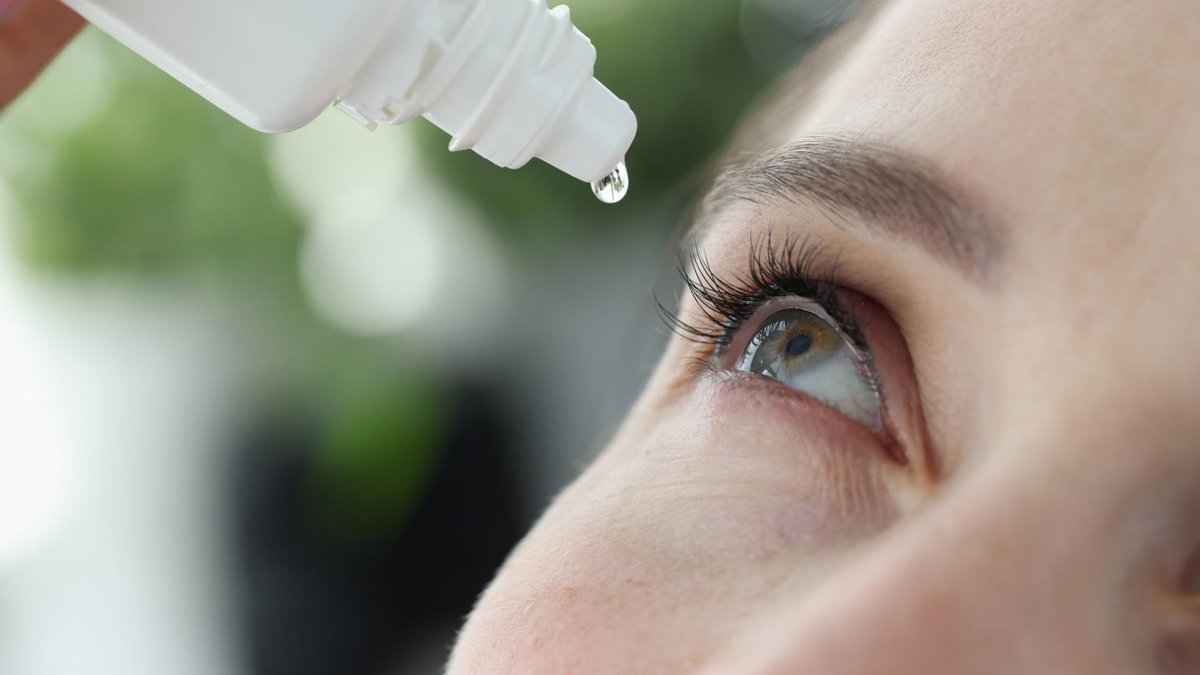
Learn helpful tips and tricks to properly apply eye drops for glaucoma.
Keep It Clean!
Wash your hands before putting in your eye drops, and do not allow the tip of the dropper to touch your eye, eyelid, eyelashes, or fingers. Another often overlooked source of contamination is the bottle cap, so be sure to place it on a clean surface such as a fresh tissue. If you do have to clean the bottle tip because of accidental contamination, use a clean tissue or a rubbing alcohol pad. Remember to close the bottle after each use too, as open bottles are more easily contaminated. Avoid keeping your eye drop bottle in your pocket, car, or in direct sunlight where it can get hot.
Find the “Pocket”
If you do not have neck problems, tilt your head back while sitting or standing. Another method is to stand in front of a mirror to help guide you. Your head will not be as tilted, but this method helps some people find the correct location to instill the drop. With the index finger of your non-dominant hand, gently pull down your lower eyelid to form a “pocket.” Look gently up and squeeze one drop into the pocket in your lower lid using your dominant hand. Do not blink excessively (see the “Close and Press” tip below). Close your eye and keep it closed for 2 minutes. Use a clean tissue to wipe away the excess eye drop. If your hands are shaky, you can brace the hand holding the bottle with your non-dominant hand, which is simultaneously pulling down your lower eyelid. If you do have neck problems, then lying flat on your back and following the above steps without the mirror will also work.
Video: How to Apply Eye Drops
Close and Press
Patients often worry about not getting enough of the eye drop into the eye because they feel some of the eye drop running down their face. As discussed in the “Cold and Wet” tip below, a single drop is more than enough for the eye to handle. However, in order to help the eye drop penetrate your eye, the easiest thing to do is to keep your eyes closed for 2 minutes after instilling the drop because blinking activates the “pump” that drains your tears away from the eyeball. This is a good time to relax and take a moment to refresh yourself during your day.
Punctal Occlusion
A second way to ensure penetration of the eye drop into your eye is to perform “punctal occlusion.” This involves pressing your finger (your index finger is recommended) near the inside corner of your eye for 2 minutes after instilling the eye drop. Your eyeball’s drainage system for your tears is in this area, and by pressing it closed you prevent the medication from draining away from your eyeball and into your nose. An added bonus is that this maneuver prevents the medication from making its way into the nose, throat, and the rest of the body, so that any eye drops that could have side effects on your body as a whole are minimized. Therefore, the ideal way to instill your eye drops is to combine both methods: close your eyes and press on the inside corners for 2 minutes after a drop is instilled.
Timing is (Sort Of) Everything
Patients often want to know how long they should wait between taking different eye drops and what the ideal timing is. Since the first eye drop can wash away the second eye drop if instilled in the eye too quickly, it is recommended to wait 5 minutes between instilling different types of eye drops (or at least 3 minutes if you are in a rush). If you have two or more types of eye drops to put in at the same time, the order in which you instill them does not matter, unless you are using an ointment. An ointment should go in at the very end after you have instilled all of your eye drops. This is because ointments create a sticky film or barrier on the eye, which would prevent any eye drops instilled afterward from penetrating.
In terms of timing, for a drop that is taken once a day, there are some medications that are better taken in the morning and others that are better taken in the evening. For example, one class of medications, the prostaglandin analogues (including latanoprost, bimatoprost, and travoprost) should be instilled at bedtime once a day. For drops that are required twice a day, the ideal dosing regimen is every 12 hours, and for drops that are dosed three times a day, the ideal dosing regimen is every 8 hours. However, sometimes that is not practical, and wiggle room of an hour or two (early or late) should be fine. The most important thing is to make sure you instill the drops the correct number of times each day.
“Cue” Yourself
Many patients have difficulty remembering to take their eye drops because they forget, the day just gets away from them, or they are already taking so many other medications that their glaucoma drops fall by the wayside. One effective way to ensure that you take your eye drops is to use them when you are doing another daily activity. For example, if you have a drop that needs to be used twice a day, you could instill it before or after brushing your teeth, or before you eat breakfast and dinner. You could also keep the eye drops next to your toothbrush if you were using teeth brushing as your “cue.” Another method is to set multiple alarms, such as on your phone. A third way is to keep a chart and check off a box each time you use your eye drop. This is especially helpful if you tend to forget whether you used your eye drop, which is quite common!
Cold and Wet
Patients often say they are unsure if enough of the eye drop entered the eye because they mostly feel the eye drop on their cheeks. While every eye drop is different in its exact size, all bottles are designed in a way such that the eye drop contains much more medicine than your eyeball can even handle. This means that you do not have to worry if excess medication drips down your cheek, and you can be assured that enough has reached your eye. This also means that you should not purposely instill 2 or more drops in an attempt to get more into your eye, as you will be wasting the medication and may run out before your next refill. Another trick is to store your eye drops in the refrigerator. You will know that the eye drop has reached your eye when you feel the cold sensation.
Talk to Your Pharmacist
Now that many glaucoma medications have gone generic, some eye drops come in bottles of all shapes and sizes. If you find that you are having trouble squeezing the bottle, or you notice that you are running out of drops too quickly even though you are only using one drop at a time, talk to your pharmacist. He or she may be able to recommend a different generic formulation that comes in a better-suited bottle for your needs or show you how to use the bottle correctly.
Get an Audience
It is always a good idea to show your ophthalmologist your eye drop instillation technique. He or she can ensure that you are correctly instilling the medication, as well as offer pointers on your technique. You can also ask a family member or friend to watch you instill your eye drops when you are first learning. And do not be afraid to ask for help. If you have difficulty with your eye drops because of conditions that even practice cannot help, such as severe arthritis, ask family and friends for help in instilling the drops, following the guidelines listed above.
Soothe Your Eyes
Many of the eye drops used for glaucoma treatment are irritating to the eye, and some eye drops also burn when they are instilled. One way to help with this is to use artificial tears BEFORE you instill your glaucoma eye drops (preferably preservative-free if you have sensitive eyes or are using many different types of glaucoma eye drops). You should wait 5 minutes after putting in the artificial tears before starting your glaucoma eye drops. There are also over-the-counter gels or ointments used at nighttime (often they are labeled “PM”) that are thicker and can help soothe your eyes overnight. If you do choose to use these formulations, make sure they are preservative-free, wait 5 minutes after your last glaucoma drop goes in, and use the gel or ointment last. And as always, tell your ophthalmologist all of the eye drops that you are using, including over-the-counter products such as artificial tears.
Bonus Tips
Bring your eye drops with you to every appointment. This way your eye doctor can make note of exactly what drops you are using, including which formulation and any confusion about your eye drop regimen and schedules can be easily sorted out.
Learning how to properly instill eye drops takes time and practice. You can use a bottle of artificial tears to practice so as not to waste your glaucoma medications.
Summary
10 Tips for How to Put in Eye Drops
- Keep It Clean!
- Find the “Pocket”
- Close and Press
- Punctal Occlusion
- Timing is (sort of) Everything
- “Cue” Yourself
- Cold and Wet
- Talk to Your Pharmacist
- Get an Audience
- Soothe Your Eyes
About BrightFocus Foundation
BrightFocus Foundation is a premier global nonprofit funder of research to defeat Alzheimer’s, macular degeneration, and glaucoma. Since its inception more than 50 years ago, BrightFocus and its flagship research programs—Alzheimer’s Disease Research, Macular Degeneration Research, and National Glaucoma Research—has awarded more than $300 million in research grants to scientists around the world, catalyzing thousands of scientific breakthroughs, life-enhancing treatments, and diagnostic tools. We also share the latest research findings, expert information, and resources to empower the millions impacted by these devastating diseases. Learn more at brightfocus.org.
Disclaimer: The information provided here is a public service of BrightFocus Foundation and is not intended to constitute medical advice. Please consult your physician for personalized medical, dietary, and/or exercise advice. Any medications or supplements should only be taken under medical supervision. BrightFocus Foundation does not endorse any medical products or therapies.









